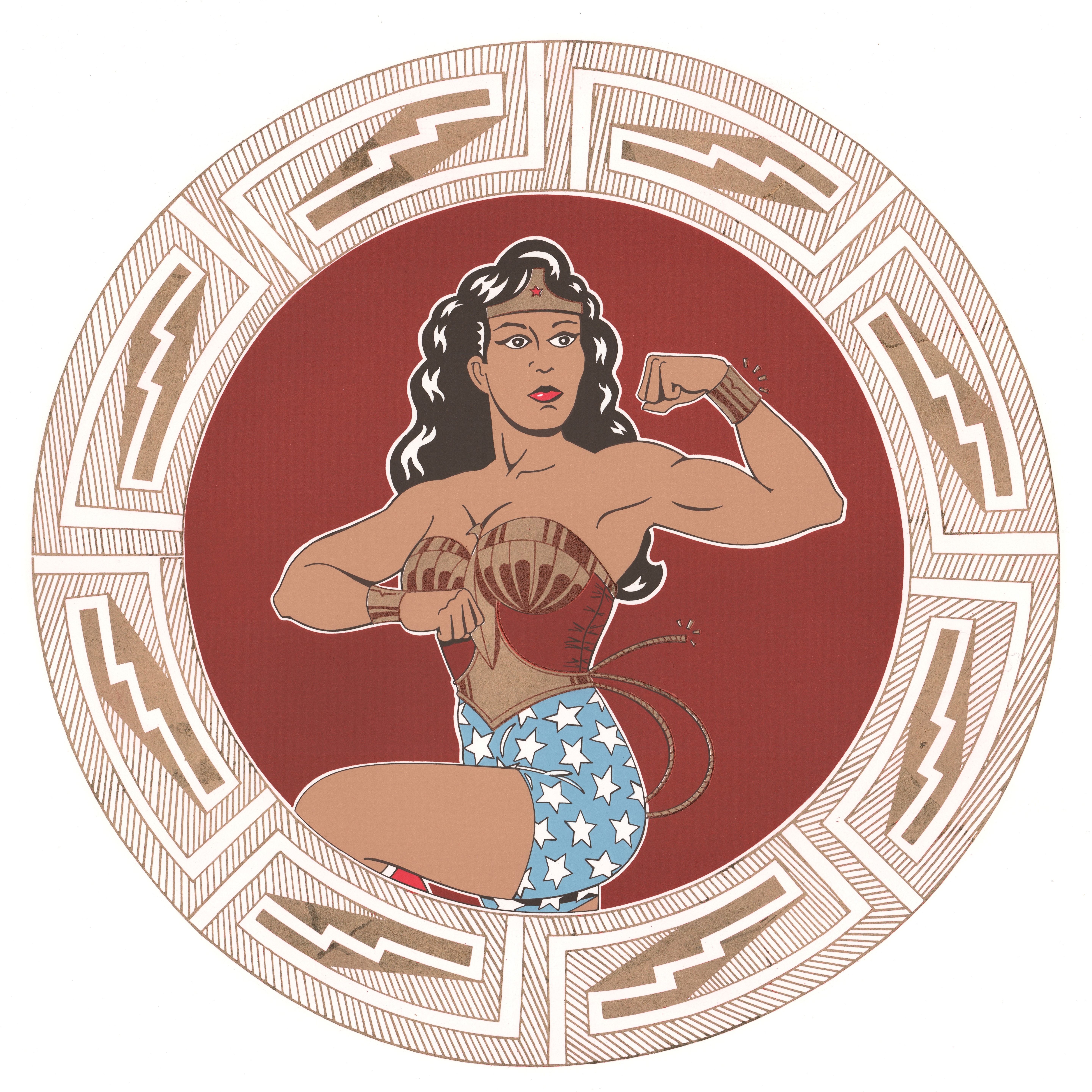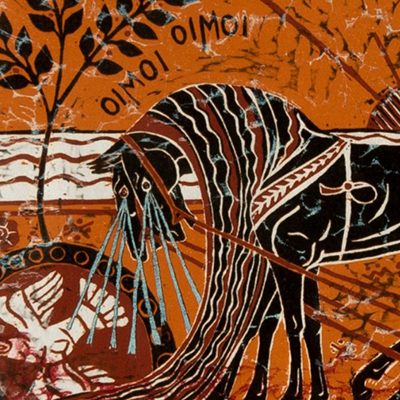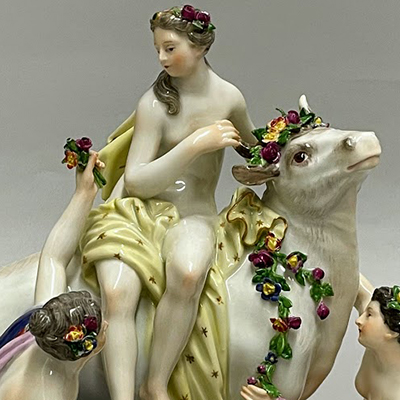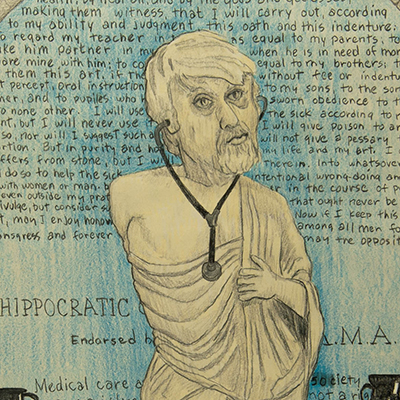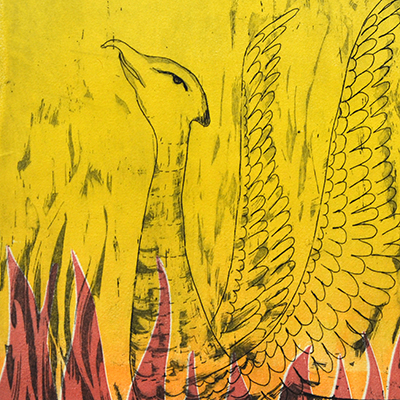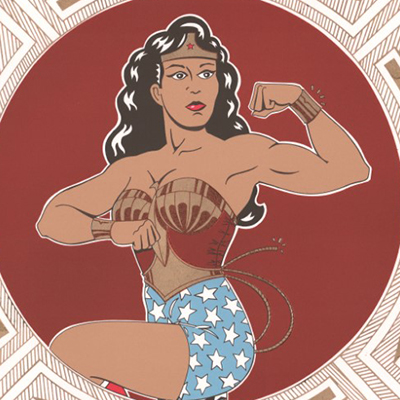In collaboration with the museum and curatorial studies minor program, Echoes of the Classical World was curated by Dr. Anthony Silvestri's Fall 2022 ancient Greek history class. Students finalized the selection of objects from the Mulvane permanent collection, and then each chose one work to research and write an interpretive label for. They finished the semester by writing a research paper on a topic related to their chosen object. Below are a few highlights from the exhibition.
Sally Piller, Oimoi (For Jack), late 20th to early 21st century, color woodcut
Oimoi (For Jack), a lithograph by Sally Piller, is a modern depiction of the story of Xanthus and Balius, two immortal horses who were the sons of either Poseidon, god of the sea, or Zephyrus, the West wind himself, depending on the version of the story. Regardless of who their father was, both would make them incredibly fast. According to Homer’s Iliad, these horses were passed down family lines until they came into the possession of the Greek hero Achilles. Only Achilles’ longtime friend and lover, Patroclus, could truly control the horses and, when Patroclus died, the horses and grieved just as much as Achilles. It is this image that is depicted in Oimoi (For Jack). The Greek word “oimoi” loosely translates as the exclamation “woe is me,” which complements the content of the piece.
Though this is a contemporary print, Piller borrows heavily from the Ancient Greek tradition of black-figure pottery, developed in Corinth around 700 BCE. The distinctive black and red look comes from the technique of protecting the background of an image to protect it from the smoke of the kiln. Anything not protected would quickly become black from the soot.
Text by Adin Replogle
Meissen Porcelain Factory, Europa on the Bull, late 19th to early 20th century, porcelain
Zeus, god of the sky, spotted Europa, the Phoenician princess, with her maidens in a field. He desired her, yet feared Hera’s wrath, so he disguised himself as a white bull, and visited the field where Europa was. There, the young maidens were infatuated with the bull’s beauty and his mild temperament. They gathered around him, petting, praising, and adorning him with flowers. Europa, intrigued by his docility, climbed upon his back, inviting her friends to join her. Yet, before they could, Zeus carried Europa away to the island of Crete, never to be rescued. This sculpture showcases the mere moment before Europa was taken, a frozen image of innocent adoration and youthful beauty. A brilliant depiction of the calm before the storm, this piece speaks to the idea of focusing on the beauty while ignoring the tragedy.
Text by Haven Simnitt
Robert Ault, Self in a Social Dream: Myself as Hippocrates, 1994, graphite and colored pencil on paper
In Self in a Social Dream: Myself as Hippocrates, art therapist Robert Ault casts himself as the “Father of Medicine” and sets the Hippocratic oath behind his statue in order to express his frustrations with the United States health insurance industry. He contrasts the intentions behind the oath—to help the sick to the best of the oath taker’s abilities—with his observations about how modern-day health coverage and prices can determine which patients live or die. To further tie his work to its ancient Greek influences, Ault included Athens-originated red figure pottery alongside his self-styled statue in the center. It is modeled after a statue of Hippocrates that is currently located in the archaeological Kos Museum, on the island where Hippocrates was born.
Text by Hannah Rogers
Mercia McDermott, Phoenix— Rebirth, 1972-73, etching
Every 500 years, the Phoenix gathers herbs and spices to prepare for its rebirth. Afterward, it travels to the land of paradise, embeds the ingredients in its nest, and lights itself on fire. Once it turns to ashes, a new Phoenix is born. McDermott depicts the timeless, imperishable bird in its crucial phase, with its wings outstretched to fan the flames. It is not the end: a new Phoenix will emerge amidst a fiery golden-orange haze.
Text by Emmy Pope
Salvador Dalí, Neptune, 1972, embossed lithograph
This depiction of Neptune comes from a series of works called Les Chevaux de Dalí, or The Horses of Salvador Dalí. The ancient Roman god Neptune was the wielder of the trident, the tamer of horses, and the commander of the seas. The god would arise from the sea, charging forward on a chariot pulled by horses to master the waves and wind. Like his Greek counterpart Poseidon, Neptune was a patron of horses and horse racing, a sport that was popular in ancient Roman culture. Horses are wild and untamable. A symbol of power and status for classical cultures, horses represented a rawness in nature through their beauty and strength. Neptune’s horse embodies a sense of freedom and a magnificent triumph of the seas.
Text by Kelsey Bremmer
Diego Romero, Cara, 2018, five-color lithograph with gold leaf
This artwork by Diego Romero intertwines with Greek mythology and classical influences. From his early childhood Romero has been inspired by the books of The Iliad and The Odyssey, Greek and Roman mythology, and Hector and Achilles’ battle beneath the gates of Troy. The artist’s wife Cara Romero, the depicted figure, is a rising photographer and member of the Chemehuevi Native American Tribe (brand of the Southern Paiute) in the Mojave Desert, CA. This Native American version of Wonder Woman gives hope to Cara, the artist’s wife, and a nod to all warrior women in Native American cultures that are the givers, sacrifices, and protectors of life, home, and culture. Lynda Carter, the Mexican American actress who originally portrayed Wonder Woman, depicted her as an Amazon princess and a barbarian warrior who protects mankind. The Amazons are a race of warlike women with the courage of pride and riding skills and are known for the Battle of the Athenians by King Theseus. I come from a Native American background as a Black-Native American on my mother’s side.
Text by Unique Grady
Cara is a lithograph created by Diego Romero, a Native American artist who has a keen interest in Greek history, Native American pottery, and comic books. Much of Romero’s artwork stems from his Native American roots, and he primarily works in ceramics. The inspiration for this artwork comes from his experience working with pottery and his fascination with Ancient Greek history. Cara combines Greek and Mimbres pottery art styles. The center of the artwork depicts the DC character Wonder Woman, who is drawn after Romero’s wife, Cara. Wonder Woman is also heavily connected to the Ancient Greek myth of the Amazons. The Amazons were considered to be a group of all-female warriors that lived on a secluded island. The outer rim’s lines include lightning bolts, symbolizing the Greek god Zeus. The exterior rim design also shares similarities with Mimbres pottery designs.
Text by Keeton Lee
